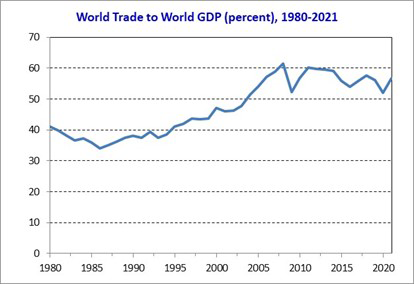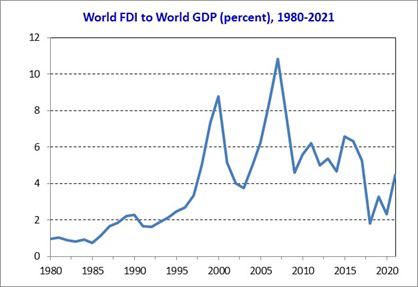This is an abridged, non-technical, updated version of two research papers:
Gunter, Bernhard G. and Britni Wilcher (2020). Three Decades of Globalization: Which Countries Won, Which Lost? The World Economy, Vol. 43, No. 4 (April), pp. 1076–1102; open access at: https://onlinelibrary.wiley.com/doi/full/10.1111/twec.12915
Gunter, Bernhard G. and Rolph van der Hoeven (2004.) The Social Dimension of Globalization: A Review of the Literature. International Labour Review, Vol. 143, Nos. 1-2 (March), pp. 7–43; open access at: https://onlinelibrary.wiley.com/doi/10.1111/j.1564-913X.2004.tb00545.x
Bernhard Gunter, Assistant Professor, Economics Department, American University
 Dr. Bernhard (Ben) Gunter is an Assistant Professor in the Economics Department of American University and the President and Founder of the Bangladesh Development Research Center (BDRC). He is a scholar and practitioner in international development economics. His areas of expertise include development macroeconomics, debt sustainability analysis, and the social impact of globalization. His current research focuses on development issues of Bangladesh. His work has been published in several pre-eminent development journals, including World Development, Development Policy Review, and Third World Quarterly.
Dr. Bernhard (Ben) Gunter is an Assistant Professor in the Economics Department of American University and the President and Founder of the Bangladesh Development Research Center (BDRC). He is a scholar and practitioner in international development economics. His areas of expertise include development macroeconomics, debt sustainability analysis, and the social impact of globalization. His current research focuses on development issues of Bangladesh. His work has been published in several pre-eminent development journals, including World Development, Development Policy Review, and Third World Quarterly.
What is Globalization?
Before addressing the question, which countries have won and which countries have lost from globalization, let’s first review what globalization is. While the term globalization is used far beyond economics, for economists, globalization refers to the overall gradual integration of national economies.
We can see this economic integration, for example, in terms of increased international trade: The world average trade‐to‐GDP ratio increased from 41 percent in 1980 to an estimated 57 percent in 2021. Hence, world trade has grown much faster than world gross domestic product (GDP). We can also look at globalization in terms of increased international investment: At the global level, the ratio of Foreign Direct Investment (FDI, net inflows and net outflows) to GDP has increased from 1.0 percent in 1980 to 4.5 percent in 2021. Hence, FDI has also grown much faster than world GDP.
Another key factor of globalization is an increased cross-border production, which is also referred to as fragmentation of production, internationalization of production, and global value chains. This aspect of globalization has been in the headline news during the height of the COVID-19 pandemic due to several break-downs in these global value chains, causing shortages and inflation all over the world. Two key points related to this internationalization of production are: first, international trade increasingly appears to be in intermediate products (not so much in final products), and second, today, multi-national corporations (MNCs) account for over two-thirds of world trade, and their share is even greater in the trade of technologically advanced products.
Has globalization been a steady process over the last few decades?
No, this process has been far from even. As shown in Figure 1, in some years we had more globalization, in other years less globalization, in some years we have even seen a de-globalization (a decline in globalization). And looking at foreign direct investment (Figure 2), some of this globalization process has been highly volatile.
Figure 1: World Trade (exports and imports) as percent of World GDP, 1980-2021

Source: Created by author based on World Bank (2023) World Development Indicators database (Washington, DC: The World Bank); as posted on the World Bank website: https://datacatalog.worldbank.org/home (downloaded on January 5, 2023).
Figure 2: World FDI (net inflows and net outflows) as percent of World GDP, 1980-2021

Source: Created by author based on World Bank (2023) World Development Indicators database (Washington, DC: The World Bank); as posted on the World Bank website: https://datacatalog.worldbank.org/home (downloaded on January 5, 2023).
What has caused globalization?
It is useful at this point to review what has caused globalization. Technological progress has contributed to this economic integration, especially with regards to trade in services. For example, India is now a major competitor in the increasingly globalized service sector. There are many Indian Call Centers, providing customer service to U.S. companies, and some of those people providing customer service over the phone are trained to speak with a typical American accent to hide the fact that this service is provided from India.
However, it is important to stress that this economic integration is also the result of deliberate policy actions, like: trade liberalizations, especially the reduction of tariffs, capital market liberalizations, the dismantling of the welfare state, and international agreements on intellectual property rights. More generally, a standardization of policies and behaviors has promoted globalization.
It is important to realize that the first aspect of globalization: the new economic relationships based on new technologies, is typically irreversible. But the second aspect of globalization, which is the adoption of policies favoring globalization, is the result of deliberate policy choices; hence, is reversible. Indeed, some of these policies are currently in the process of being reversed in the United States and many other countries. For example, the Biden Administration announced on February 8, 2023, that it will require the use of American-made goods in government-funded infrastructure projects.
Have all countries been part of this globalization?
Despite an overall globalization, for example in terms of trade, the exports‐to‐GDP ratios have actually declined for 29 of the 118 countries with such data from 1985 to 2015. Some countries have been driving globalization, some countries have desperately tried to keep up with the countries driving globalization, while others have become marginalized. The ten most globalizing countries (in terms of exports to GDP), which are the clear winners of globalization, are Mozambique, Laos, India, Bangladesh, Nicaragua, Burkina Faso, Chad, Ghana, Thailand, and Malta. For example, Mozambique has seen an increase in its exports to GDP ratio from 4.7 percent in 1985–89 to 32.2 percent in 2011–15. These country specific data have been provided as five-year averages to limit the considerable volatility in annual data.
On the other hand, in terms of exports to GDP ratios, the ten most marginalized countries are St. Vincent & the Grenadines, Kiribati, the Gambia, Antigua & Barbuda, St. Lucia, Grenada, Jamaica, the Central African Republic, Cuba, and Burundi. For example, St. Vincent & the Grenadines saw a drop in its exports to GDP ratio from 56.4 percent in 1985–89 to 26.1 percent in 2011–15.
Is there some systematic categorization of winners and losers?
Even though all kind of countries are winners, and all kind of countries are losers, if we look at country groups by income per capita, we can see that excluding China and India, the low- and middle-income countries are overall the losers, with their exports to GDP ratio increasing only marginally from 20 percent in 1985 to 25 percent in 2015. China and India are the clear winners, which each saw their exports to GDP ratio more than doubling between 1985 and 2015. The high-income countries are somewhere in the middle, with their exports to GDP ratio increasing from 17 percent in 1985 to 29 percent in 2015. Looking specifically at the United States, the United States has been more a loser than a winner. For example, the share of the United States in world exports has declined from 13.0 percent in 1985–89 to 9.7 percent in 2011–15.
Did Globalization Have More Costs or More Benefits?
At the global level, globalization seems to have brought more benefits than costs, but globalization has led to considerable downward pressure on labor costs and wages all over the world. Workers earn in relative terms far less today than decades ago. Furthermore, a large number of developing countries has become marginal to the global economy. In those countries, employment and labor standards have been declining. The United States also faced huge pressures to reduce wages.
What about Poverty, Inequality, and Economic Insecurity?
Based on an extensive review of the literature by Gunter and van der Hoeven (2004), the overall impact of globalization on poverty remains highly disputed. Some studies conclude that globalization has decreased poverty, while about equally many studies conclude that globalization has increased poverty. However, there is broad agreement in the literature that globalization has increased inequalities across countries, and especially within most countries. There is also some agreement among researchers that globalization has increased economic and political insecurity.
What are the key determinants for why some countries have been winners and some countries have been losers of globalization?
There is a huge literature on empirically examining the determinants of globalization. Gunter and Wilcher (2020) took an entirely new approach to answer this question. Instead of running typical cross-country times series regressions, they focused on periods of globalization and periods of marginalization, though defined for each country. Without going into the more complicated details, an episode of significant globalization is defined as a five-year period during which a country’s share in world exports has increased at least two times the average change in world exports during that period. On the other hand, an episode of significant marginalization is defined as a five-year period during which a country’s share in world exports has declined at least two times the average change in world exports during that period.
Limiting the analysis to periods of globalization and periods of marginalization does not only reduce the considerable noise in the relationship between exports and GDP, but it also allows to focus on the true cases of globalization and the true cases of marginalization. And in terms of regression analysis, this then allows to run what is called a binary regression, a Probit regression, whereby periods of globalizations are given the value “one” and periods of marginalization are given the value of “zero”. Given their completely new methodology, Gunter and Wilcher (2020) then focused their regression analysis on the most agreed determinants of globalization in the literature, which are education, investment in infrastructure, macroeconomic instability, changes in the average adult fertility rate and the share of net FDI inflows to GDP.
Running many different specifications and performing a variety of robustness checks, their results showed that differences in education and differences in macroeconomic instability are the two most robust determinants for experiencing globalization and marginalization in terms of world export shares. However, this should not be interpreted as that only education and macroeconomic instability are determinants of world export shares. For example, infrastructure becomes a determinant if lowering the significance level to 90 percent.
Conclusion
Overall, we saw a significant integration of national economies from during the last four decades. In terms of trade, globalization happened from 1986 to 2008. However, about one quarter of the world’s countries have not been part of this overall globalization. Instead, these countries became marginalized in the world economy. The lack of education and the lack of macroeconomic stability are key factors contributing to countries becoming marginalized. At a much broader level we can conclude that globalization needs to be managed in the right way – and too often this has not been the case. Trade and international investment can be engines of growth, but development will not happen by globalization alone.



